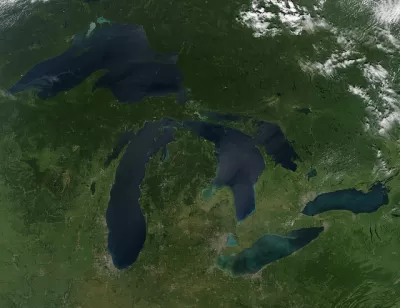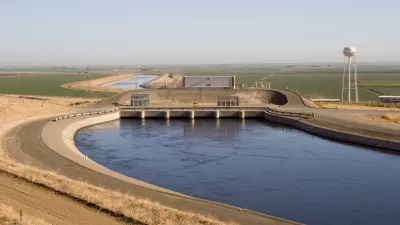The city of Waukesha asked for more water than the Great Lakes Compact would allow. Commenters remind the city of Waukesha that water for growth was never the goal of the Great Lakes Compact.

Don Behm of the Milwaukee-Wisconsin Journal Sentinel provides the big news about a decision by Great Lakes officials to cut a water diversion request intended to help the city of Waukesha, a suburb of Milwaukee, continue to grow. According to Behm, Waukesha's proposal requested an average of 10.1 million gallons a day. Great Lakes official trimmed that proposal to 8.2 million gallons a day by removing "portions of three neighboring communities from a future water service area to receive lake water," according to Behm.
An article by Angie Schmitt offers helpful perspective on the context and larger implications of the decision. "Governors of the states surrounding the Great Lakes are considering a water policy case with big implications for land development throughout the Midwest," writes Schmitt, who also provides this background:
Waukesha, Wisconsin, a sprawling suburban area outside Milwaukee, has exhausted its water resources. Rather than cooperate with the city of Milwaukee to secure water, Waukesha spent years preparing an application to divert water from Lake Michigan. Waukesha needs permission from the states and provinces that signed the Great Lakes Compact, a 2008 agreement to protect the world’s largest freshwater source from being pillaged.
In addition to providing that concise description of the issue, Schmitt's article shares the commentary provided by James Rowen of the Political Environment, who has been following the request since it was first proposed. According to Rowen, a recent decision by Great Lakes officials to cut the water diversion request should have been anticipated years ago.
Prior to the regional group's decision, the Wisconsin Department of Natural resources had approved the proposed change of service area.
FULL STORY: Great Lakes officials trim Waukesha's water request

Alabama: Trump Terminates Settlements for Black Communities Harmed By Raw Sewage
Trump deemed the landmark civil rights agreement “illegal DEI and environmental justice policy.”

Study: Maui’s Plan to Convert Vacation Rentals to Long-Term Housing Could Cause Nearly $1 Billion Economic Loss
The plan would reduce visitor accommodation by 25% resulting in 1,900 jobs lost.

Why Should We Subsidize Public Transportation?
Many public transit agencies face financial stress due to rising costs, declining fare revenue, and declining subsidies. Transit advocates must provide a strong business case for increasing public transit funding.

Paris Bike Boom Leads to Steep Drop in Air Pollution
The French city’s air quality has improved dramatically in the past 20 years, coinciding with a growth in cycling.

Why Housing Costs More to Build in California Than in Texas
Hard costs like labor and materials combined with ‘soft’ costs such as permitting make building in the San Francisco Bay Area almost three times as costly as in Texas cities.

San Diego County Sees a Rise in Urban Coyotes
San Diego County experiences a rise in urban coyotes, as sightings become prevalent throughout its urban neighbourhoods and surrounding areas.
Urban Design for Planners 1: Software Tools
This six-course series explores essential urban design concepts using open source software and equips planners with the tools they need to participate fully in the urban design process.
Planning for Universal Design
Learn the tools for implementing Universal Design in planning regulations.
Smith Gee Studio
Alamo Area Metropolitan Planning Organization
City of Santa Clarita
Institute for Housing and Urban Development Studies (IHS)
City of Grandview
Harvard GSD Executive Education
Toledo-Lucas County Plan Commissions
Salt Lake City
NYU Wagner Graduate School of Public Service




























